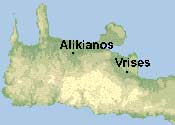
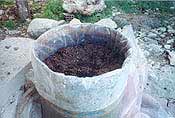
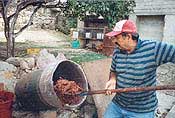
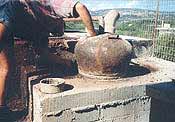
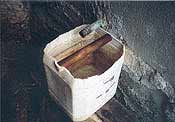
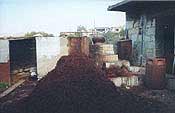
|
Folklore - Ancient Crafts
|
|||
|
Raki production or kazánisma
|
|||
|
The production |
| When
you have only one week of autumn holidays at your disposal, it can be
quite difficult to come into contact with the people who distil. As
distillation mainly occurs within three weeks (number 42, 43 and 44) and
is depending on the weather, you can easily experience, that the time of
distillation falls outside the period of your stay. And as the
distillation itself as already mentioned is not surrounded by any kind of
special festivity, it can be difficult - well, almost impossible - to get
information about where, when or with whom the distillation takes place.
|
|
|
| Raki
is a distillate of the mash (stalks, skins etc.) from the wine production.
First the grapes are pressed for the wine, and then the mash is left in
big containers for about a month - depending on the weather. Of course you
have to take care that the mash does not begin to ferment or rot, as no
chemicals or other things, which may delay the process, are added.
|
|
|
| I
have been lucky enough to experience two distillations, both of them in
the county of Chania, first time in a village a little south of Vrises and
second time in a village near Alikianos. |
||
|
|
||
| At
Vrises Christos had a copper (kazáni)
of about 100 litres. It was built into a rather funny looking construction,
which was meant to make sure of sufficient heat and tightness. But let him
tell about the process himself:
|
||
| In
the old days we used olive wood as firewood, but nowadays it is cheaper to
use waste from the olive production (pirínas).
Underneath the kazani I have provided the fireplace with a fan motor,
which increases the heat many times. It is more economical and makes the
process easier too. Before I put the mash into the copper, I place some
dried sprigs of thyme at the bottom. They prevent the mash catching.
Moreover they add taste to the raki, so according to your taste you might
use other sprigs or herbs. Then I add about 100 litres of mash, which I
stamp hard before the lid is put on.
|
|
|
| The
lid is hemispherical with an opening in the top and made from copper as
well. In the opening is mounted a several metres long pipe, where the
vapour is lead forward through a big vessel with water to cool the vapour,
which continues and then runs out through a small pipe into a "slightly
used" plastic bucket. To avoid the vapour from slipping out, all the
joints are sealed up with "zými": a mixture of flour, ashes, cement and water. Because of
the heat the mixture dries with lightning speed and creates a tight
membrane, which on the other hand can easily be broken open, when the
copper has to be emptied and refilled for the next distillation.
|
|
|
| After
half an hour the first drops begin to drip out. At the beginning it is the
so-called "protoráki", which is to strong to drink, but already after
half an hour the raki reaches a more human percentage of alcohol. The
distillation takes about an hour, until almost mere water is coming out of
the pipe, as the percentage of alcohol is going down more and more during
the process.
|
|
|
| The
strong protoráki may be kept in the distillate to keep up the percentage
of alcohol, or it may be saved and used as a massage fluid at common-cold
symptoms - which would often be the case in former days.
|
||
| The
outcome of the 100 litres of mash was about 20 litres of drinkable raki.
Of course a considerable amount of boiled mash is gathered during the
distillation period, and I imagined that it would make a splendid animal
feed, but no - I was lectured - the animals do not want to be bothered
with it. Instead it is used as manure for the olives.
|
|
|
| Not
all grapes are suitable for distillation. The dark grapes are the best, as
they give a much larger percentage of alcohol and in this way a larger
return.
|
||
| In
the old days raki was also made from figs and mulberries, but -
unfortunately - only a few "connoisseurs" carry on this
tradition.
|
||
|
|
||